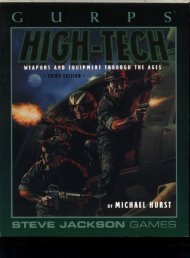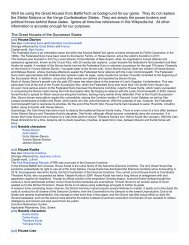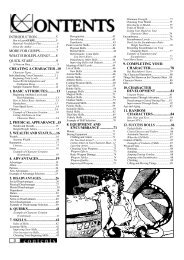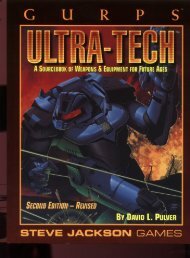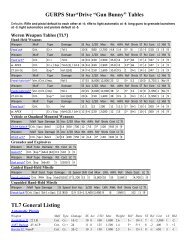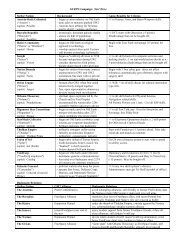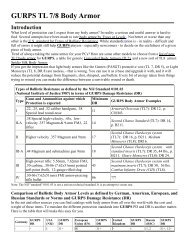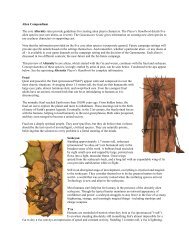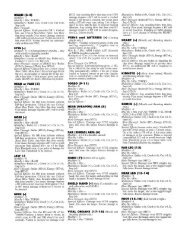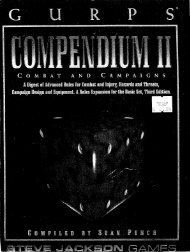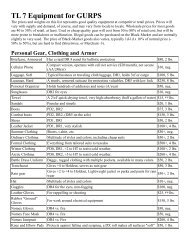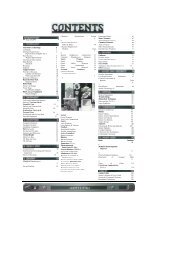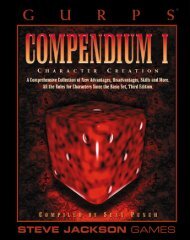Create successful ePaper yourself
Turn your PDF publications into a flip-book with our unique Google optimized e-Paper software.
ARMOR ENCHANTMENTS<br />
These spells work only on clothing, armor, and shields. They are<br />
“always on,” and are excellent protection. The drawback is that when the<br />
item is badly enough damaged, the spell also vanishes. Keep track of the<br />
number of times the item is penetrated by enemy blows. When it has been<br />
penetrated (DRx5) times, using natural DR, it is damaged enough that the<br />
enchantment leaves. If a piece of clothing has no natural DR - e.g., a<br />
cotton shirt enchanted into armor - it loses its power after the 5th<br />
penetration.<br />
Ordinary repairs may fix the item but will not count against the<br />
number of penetrations for purposes of deciding when the enchantment<br />
wears off. However, the Repair spell will accomplish this.<br />
If the advanced armor rules are used, armor may be enchanted and<br />
bought by the piece. Costs for pieces: 40% of full for the torso (30% for<br />
front only!); 10% per pair for arms, legs, hands and feet; and 20% for the<br />
head.<br />
Fortify<br />
Enchantment<br />
Adds to the damage resistance of the item upon which it is cast. DR<br />
may be increased by up to 5 with this spell. If you are building armor part<br />
by part, each item’s enchantment protects only itself, and several Fortified<br />
items may be worn. If you are using “generic” armor, use Fortify on the<br />
torso armor; it adds to DR wherever the wearer is hit.<br />
Energy cost to cast: 50 for DR +1, 200 for DR +2, 800 for DR +3,<br />
3,000 for DR +4, 8,000 for DR +5. The spell can be recast to strengthen it,<br />
as per Accuracy (p. 44).<br />
Prerequisite: Enchant.<br />
Item: Clothing or armor (but not a shield).<br />
Deflect<br />
Enchantment<br />
Adds to the passive defense of the item upon which it is cast. PD may<br />
be increased by up to 5 with this spell. If you are building armor part by<br />
part, each item’s enchantment protects only itself, and several items with<br />
Deflect may be worn. If you are using “generic” armor, use Deflect on the<br />
torso armor; it adds to PD wherever the wearer is hit.<br />
Energy cost to cast: 100 for PD +1, 500 for PD +2, 2,000 for PD +3,<br />
8,000 for PD +4, 20,000 for PD +5. This spell can be recast to strengthen<br />
it, as per Accuracy (p. 44).<br />
Prerequisite: Enchant.<br />
Item: Clothing, armor, or shield.<br />
Lighten<br />
Enchantment<br />
Makes armor or shield lighter and easier to carry. The subject becomes<br />
lighter only when it is actually being worn. Armor in a backpack would<br />
still have its full weight.<br />
Energy cost to cast: 100 to cut the item’s weight by 25%; 500 to cut its<br />
weight in half.<br />
Prerequisite: Enchant.<br />
LIMITING ENCHANTMENTS<br />
All these enchantments limit the way that enchanted items work. The<br />
GM should make sure that he gets the details in writing, to avoid<br />
arguments about when or how an item can work. Since these spells merely<br />
limit the way other spells work, they never add an energy cost for the user.<br />
These spells are hard to remove. Name, Password, and Bane cannot be<br />
removed unless the spells they limit are also removed. Limit and Link<br />
resist removal at +5, and any failure may be treated as “critical.” This can<br />
remove all spells on the item, strengthen the limit, or have any other result<br />
the GM feels is inconvenient for the clumsy mage.<br />
If an item has multiple spells on it, including one or more limiting<br />
spells, the mage casting each spell determines whether it governs (or is<br />
governed by) previous spells. For instance, a named sword might have +3<br />
against ores for any user, but act as a Dancing Sword only for one who<br />
knew its name.<br />
Name<br />
Enchantment<br />
Gives a magical name to an enchanted object. The magic of the subject<br />
will function only for one who knows its name. The user must speak the<br />
item’s name the first time he tries to use it, to show he knows the name.<br />
Energy cost to cast: 400, or 200 if the name is written on the item. It<br />
must be readable (GM’s decision). It may be small, hidden or even<br />
disguised, but a person examining the item must be able to see it.<br />
Prerequisite: Enchant.<br />
Password<br />
Enchantment<br />
The reverse of the Name enchantment. A magical item with a<br />
Password will function unless the Password is spoken. If the Password is<br />
spoken, the item will be inert until the next time its powers would<br />
normally be invoked - or for one minute (choice of person making the<br />
item). An item may have some spells that are passworded and others that<br />
are not. The details, of course, depend on the spell. Examples might be (a)<br />
a magic ring that gave the power of flight - but put the wearer in<br />
Suspended Animation unless the password was used; (b) a Pentagram that<br />
can be “turned off” with a word; (c) an Air-Golem swinging a sword, that<br />
stops for one minute if the password is said.<br />
Energy cost to cast: 400. Halve this cost if the password is written on<br />
the item (must be readable).<br />
Prerequisite: Enchant.<br />
Limit<br />
Enchantment<br />
The enchanted item will work only for the user, or class of users,<br />
specified by the caster when the Limit is cast. This class of users may be<br />
as simple or complex as the caster wishes. A Limit spell may affect all the<br />
spells on the item, or just some of them.<br />
Energy cost to cast: 200.<br />
Prerequisite: Enchant.<br />
Link<br />
Same as the “Item” description under Meta-Spells, p. 64.<br />
Enchantment<br />
SPELL LIST<br />
- 46 -



